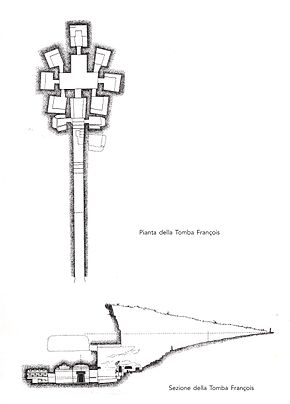François Tomb

Ground plan of the François Tomb
|
|
| Location | Comune di Vulci, Italy |
|---|---|
| Region | Province of Viterbo |
| Type | tomb |
| History | |
| Founded | late fourth century BC |
| Cultures | Etruscan |
| Site notes | |
| Excavation dates | 1857 |
| Archaeologists | Alessandro François and Adolphe Noël des Vergers |
| Condition | ruined |
| Public access | no |
Coordinates: 42°25′2.8″N 11°38′20.6″E / 42.417444°N 11.639056°E
The François Tomb is an important painted Etruscan tomb from the Ponte Rotto Necropolis in the Etruscan city of Vulci, in central Italy. It was discovered in 1857 by Alessandro François and Adolphe Noël des Vergers. It dates to the last quarter of the fourth century BC. The tomb seems to belong to the Etruscan family of the Saties (or Seties) and one of its chief occupants is Vel Saties, who appears with his dwarf, Arnza.
Its outstanding frescoes are significant both iconographically and also in terms of their comments on Etruscan history and identity.
The tomb contains a fresco depicting Caelius Vibenna (whom the Romans believed the Caelian Hill was named after) and Mastarna (a legendary figure whom the Emperor Claudius identified with Servius Tullius).
The frescos were removed by Prince Torlonia soon after their discovery and were kept in the Torlonia Museum (Rome). Since 1946, they have been stored at the private Villa Albani in Rome as part of the Torlonia collection.
Some pottery vessels from the tomb are now in the British Museum.
...
Wikipedia

